Banbury cakes are pastries laden with dried fruit from Oxfordshire. These easy-to-make pastry ovals are filled with currants and mixed peel and make a great sweet snack.
Similar British bakes include Eccles cakes, Chorley cakes and Coventry God cakes. Think of these regional bakes as siblings – they have characteristics in common but they also have their own personalities.
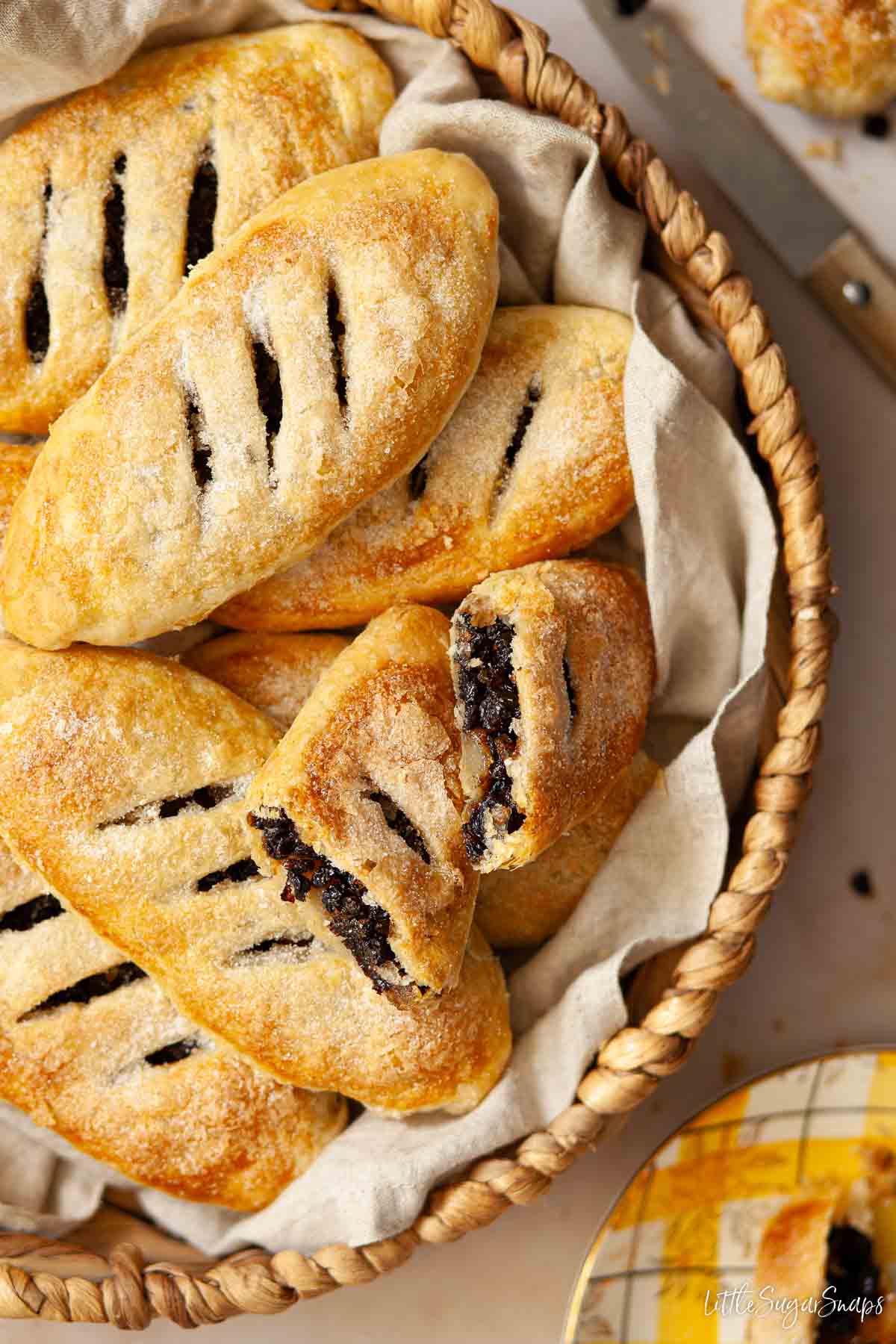
Want to Save This Recipe?
Why you’ll love this recipe
- Cheats puff pastry: I’ve used my homemade flaky pastry to make these Banbury cakes. You can either use my recipe or make your own proper puff pastry (or use store-bought puff pastry) if you want to be totally authentic.
- A simple yet tasty filling makes these pastries particularly moreish.
- Rustic charm: shaped by hand these pastries retain plenty of charm.
Banbury cakes are small, sweet oval shaped pastries filled with currants and candied peel. They originate from the town of Banbury in Oxfordshire, England, and in days gone by they were eaten on Feast Days, such as St George’s Day, Easter, Ash Wednesday, Pentecost etc.
Though called a cake they are in fact made from crisp and flaky puff pastry and are really dinky little pies filled with juicy dried fruit rather than being an actual cake.
Don’t miss my other traditional British bakes. Many make fine use of dried fruits too, including currant buns, tea bread, Shrewsbury biscuits and sweet suet pudding.
Discover more about Banbury cakes
What are Banbury cakes made from?
Banbury cakes are traditionally made from puff pastry with a filling consisting:
- currants
- candied peel
- nutmeg
- mixed spice
- rum
- rosewater
An egg white glaze and a sprinkle of sugar finishes these rustic treats off nicely.
Banbury cake history
Banbury cakes have been knocking around since the 13th century when crusaders brought dried fruits and spices to England. Needless to say, they are a well-establsihed and much-love British baking recipe.
Can I buy Banbury cakes?
You can order Banbury cakes online or find them in bakeries in Banbury itself.
Ingredients notes

Pastry: for the very best flaky pastry, only butter will do. It’s streaks ahead in terms of flavour compared to baking margarines. And the solid nature of chilled butter is essential when creating a crispy, flaky pastry.
Currants: these are the core ingredient in the filling of Banbury cakes and it would be a grave mistake to replace them with raisins or sultanas. Vostizza currants (also available from M&S) are soft and full-flavoured.
Mixed Peel: another key ingredient, opt for quality candied peel and chop it yourself. It’s far superior to the cheap pre-chopped variety in the supermarket.
Spices: mixed spice and nutmeg are my spice preferences here, but if you want to leave them out or swap them for your favourite, that’s fine.
Rum: another integral ingredient in a traditional Banbury cake. I would only recommend omitting it if you need to for dietary requirements. The pastries do not taste particularly boozy but the rum does bolster the overall flavour of the fruity filling.
Rosewater: included in traditional recipes but if you do not fancy adding gentle floral undertones to your bake it can be omitted.
Equipment notes
A large circular cutter is ideal – I found a 14cm cutter on Amazon. However, you can use a similarly sized upturned plate or bowl and cut around that.
Step by step instructions
Full instructions and measurements are given in the printable recipe card at the end of this post.
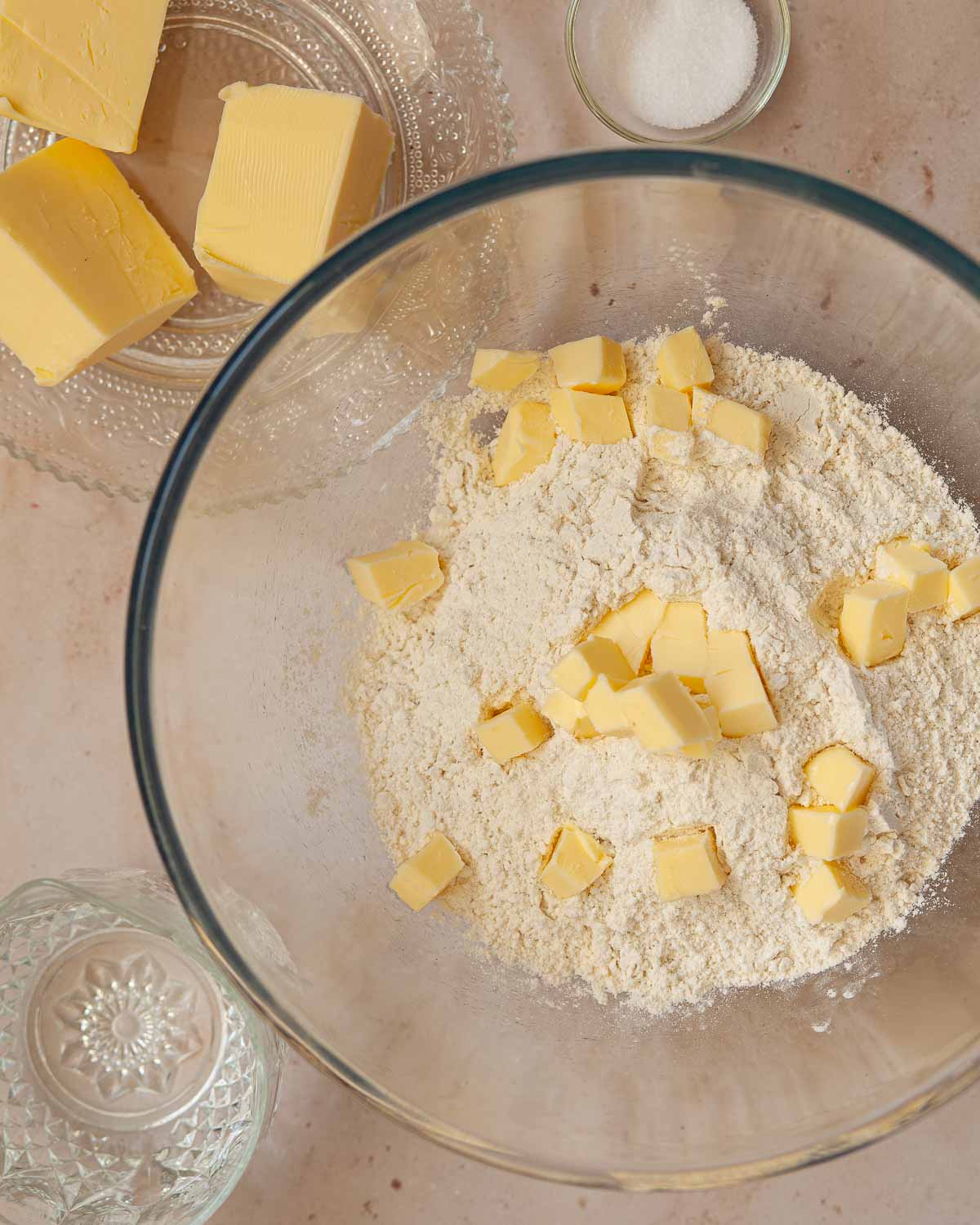
Step 1.Divide the butter into 4 portions.
Put the flour and salt into a bowl and stir briefly then add 1 portion of the butter (cubed) and rub it in.
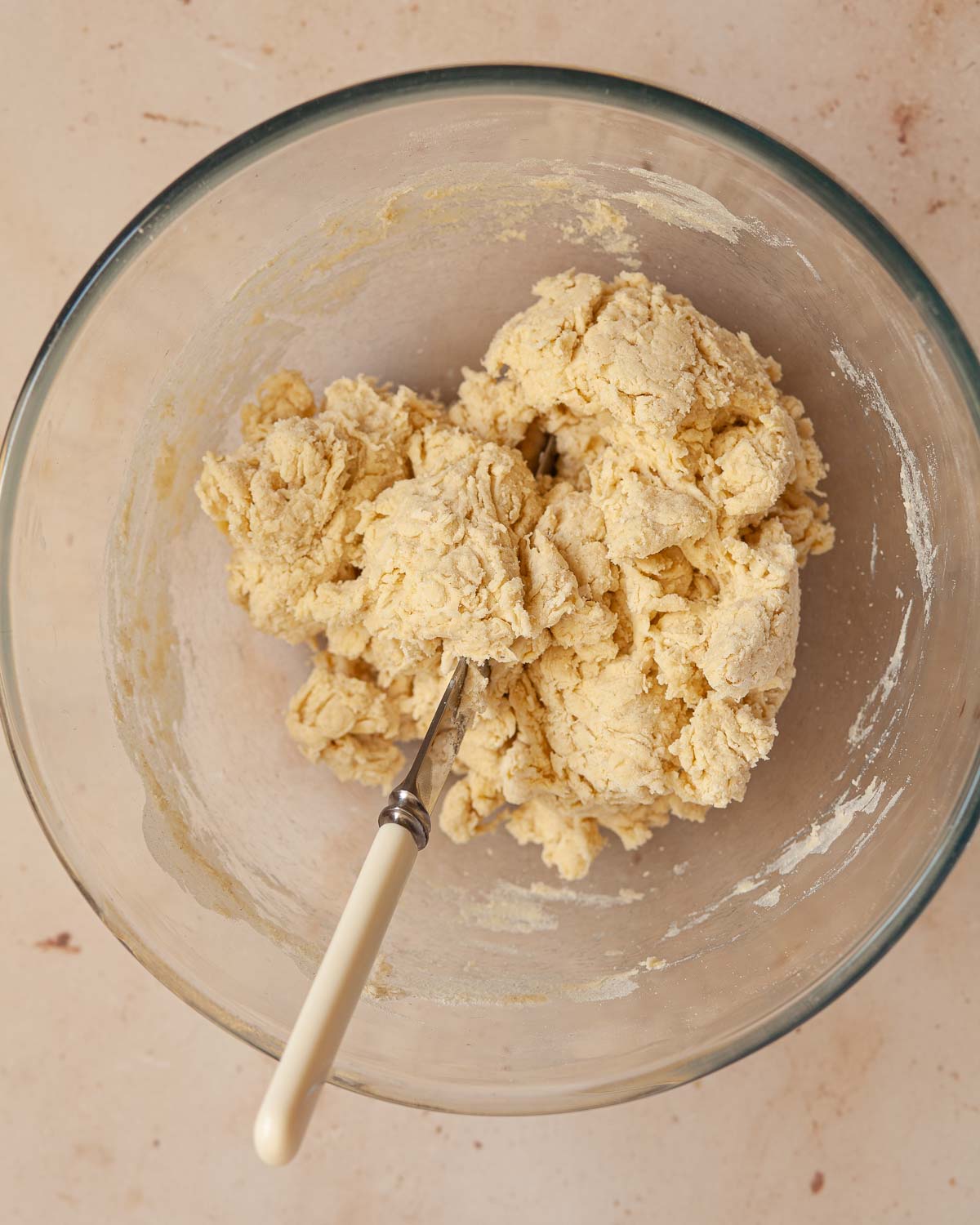
Step 2. Pour in ¾ of the water and mix, with a blunt knife, to a soft dough, adding more water as necessary (do not add so much that the dough turns sticky.

Step 3. Roll the dough into a long rectangle on a lightly floured worktop to approx 4mm thick. Take another portion of the butter, cube it and scatter it over ⅔ of the dough, leaving the final ⅓ empty.
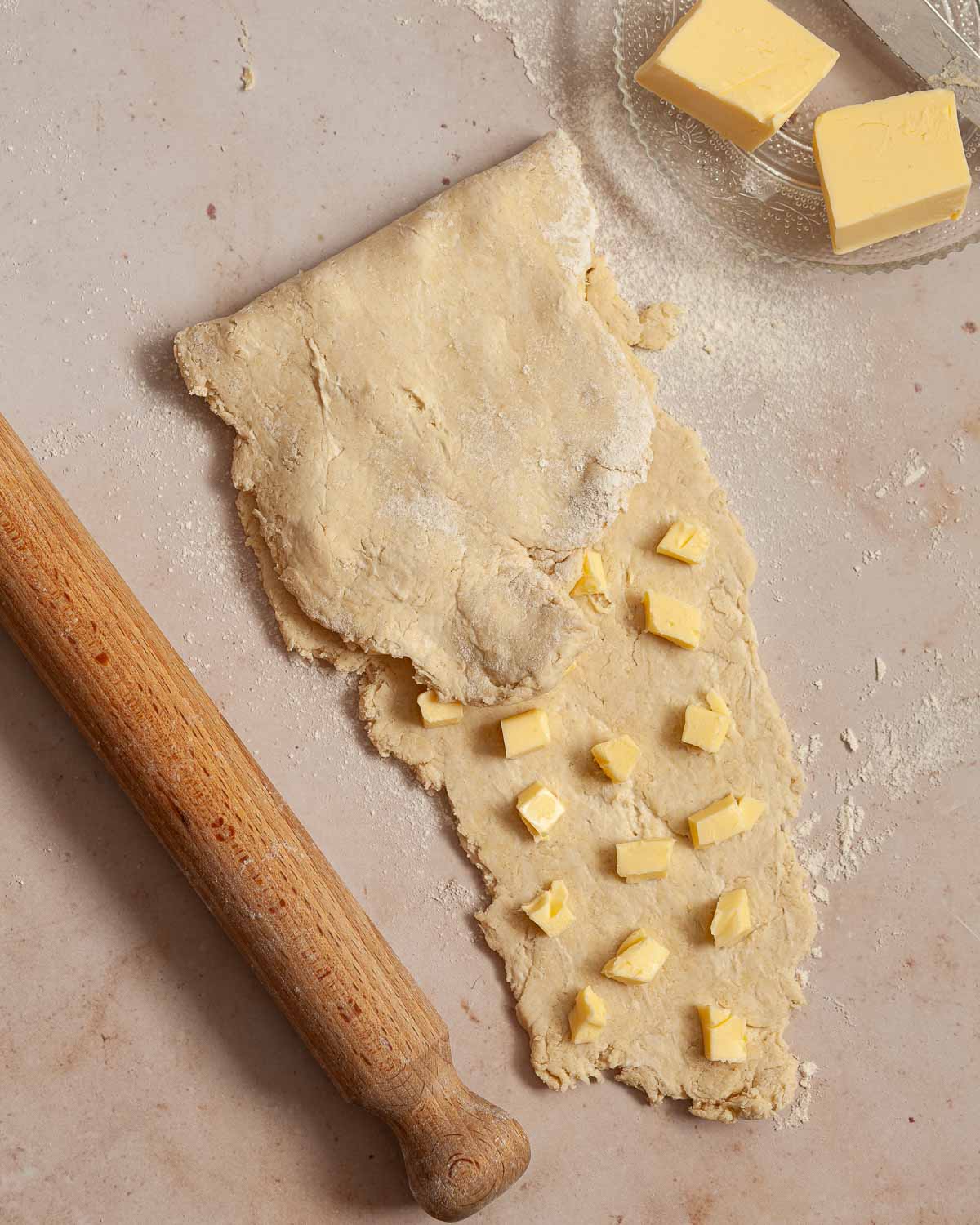
Step 4. Fold the empty third of the dough over the top of the dough, bringing it to the centre.
Fold the other end of the pastry over the top, then rotate the pastry 90 degrees.
Roll the pastry out in one direction and repeat the folds & 90 degree rotation above (without adding more butter) two more time then cover the pastry with food wrap and chill for 20 minutes.
Step 5. Repeat steps 3 & 4 twice more to incorporate the remaining portions of butter. Chill the finished pastry for 1 hour in the fridge.
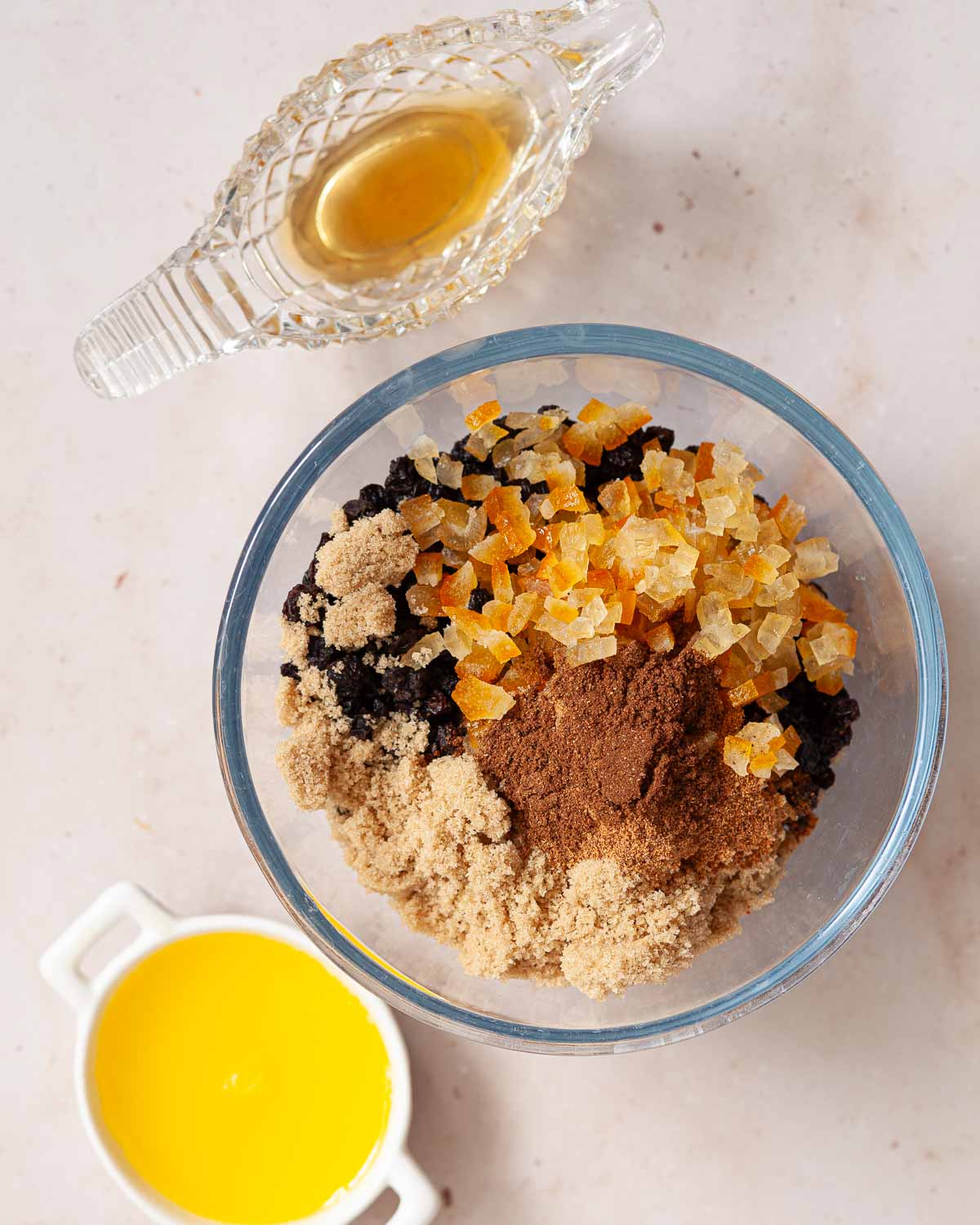
Step 6. When ready to proceed to assemble the Banbury cakes prepare the filling by mixing the currants, candied peel, spices and sugar in a mixing bowl. Melt the butter and stir it into the bowl along with the rum and rosewater (if using).
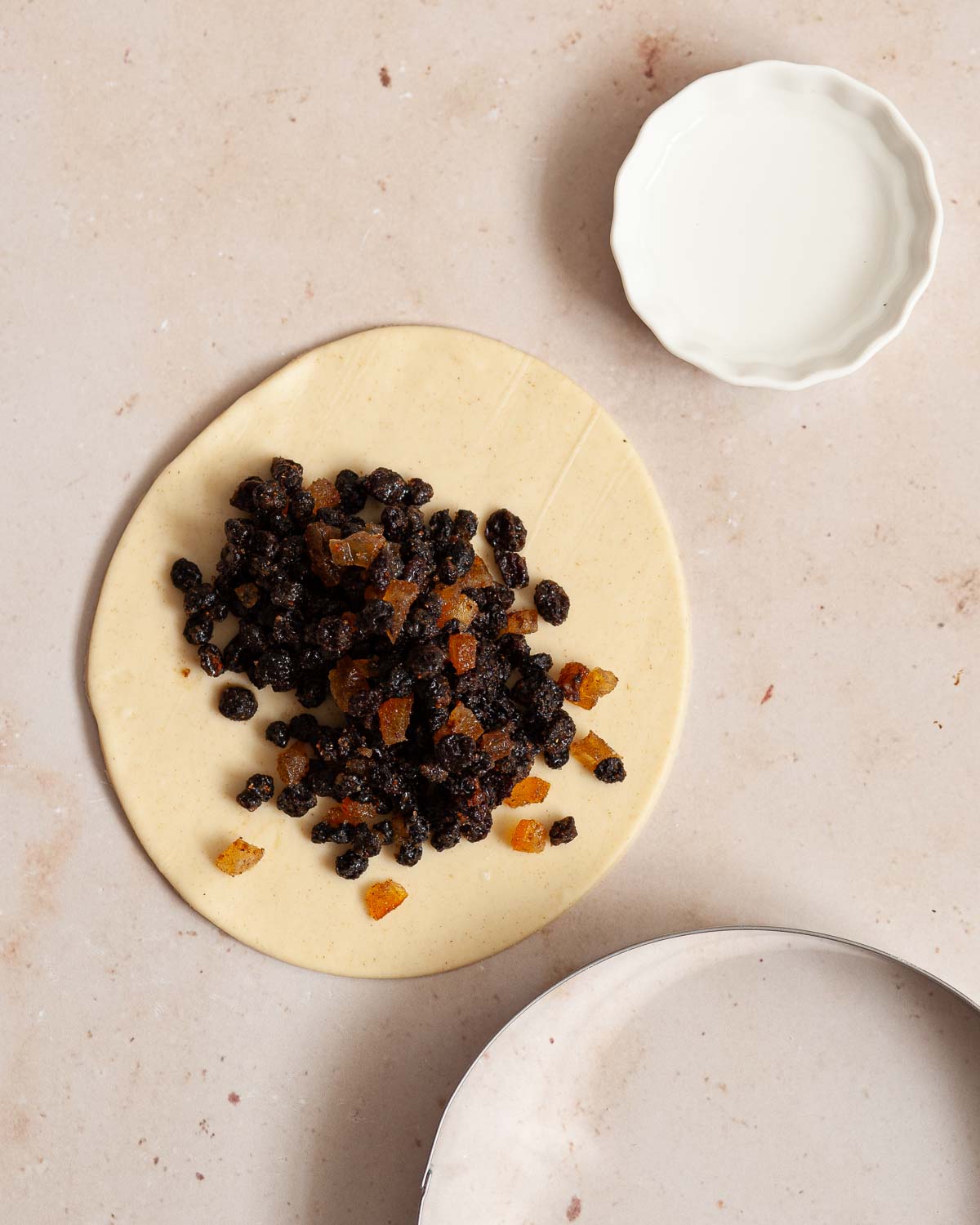
Step 7. Roll the pastry dough out on a lightly floured worktop and cut circles approximately 14cm diameter (aim to cut 6 from the first roll).
Pile the off-cut pastry pieces on top of each other (do not squish them together to form a ball).
Re-roll the pastry to cut another 2 circles.
Divide the filling between the 8 circles.
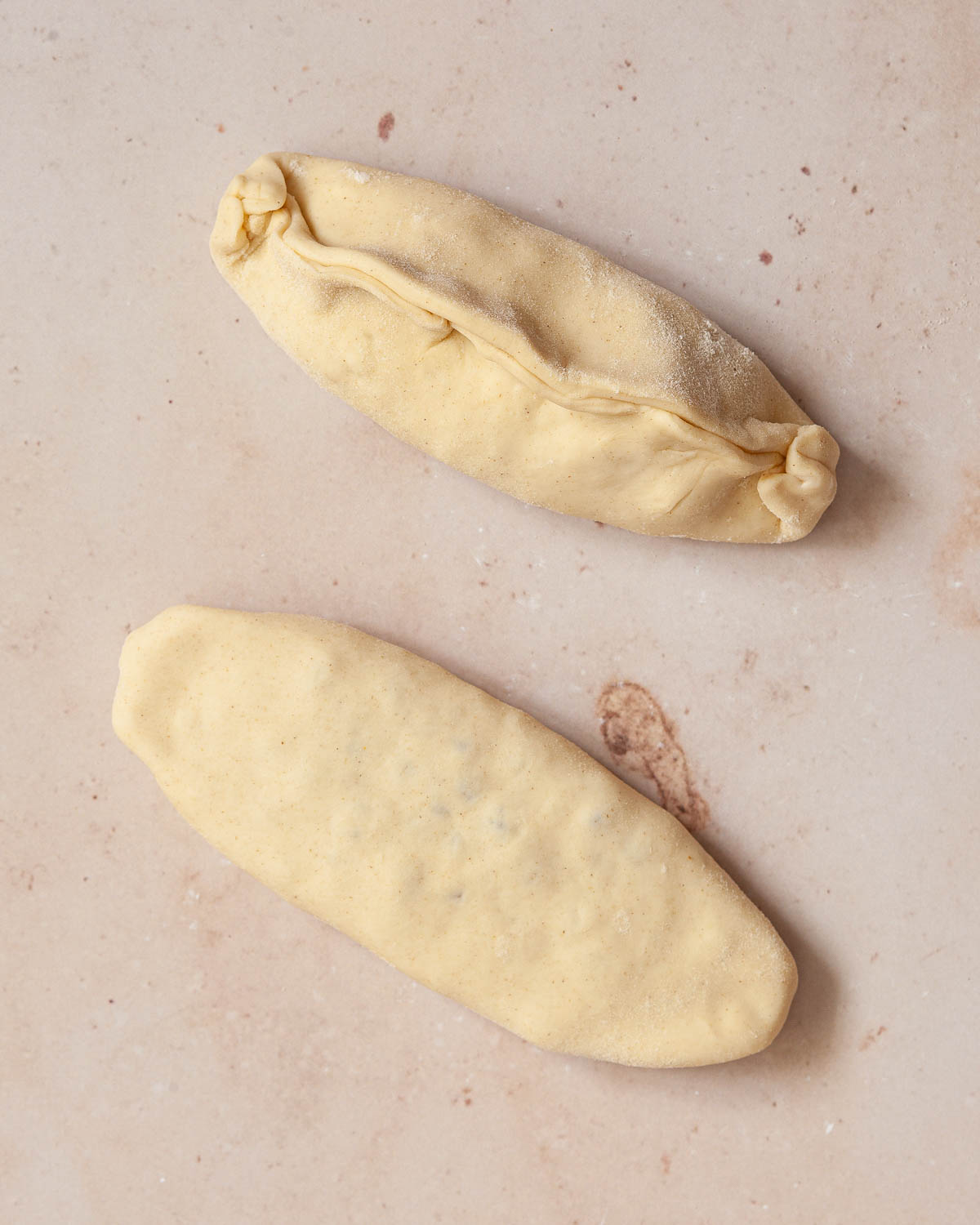
Step 8. Lightly brush the edge of each circle with egg white and bring the edges up to meet in the centre, pressing them together. Tuck in the ends.
Turn the cake over so that the seal is underneath and lightly flatten the pastry to form an oval.
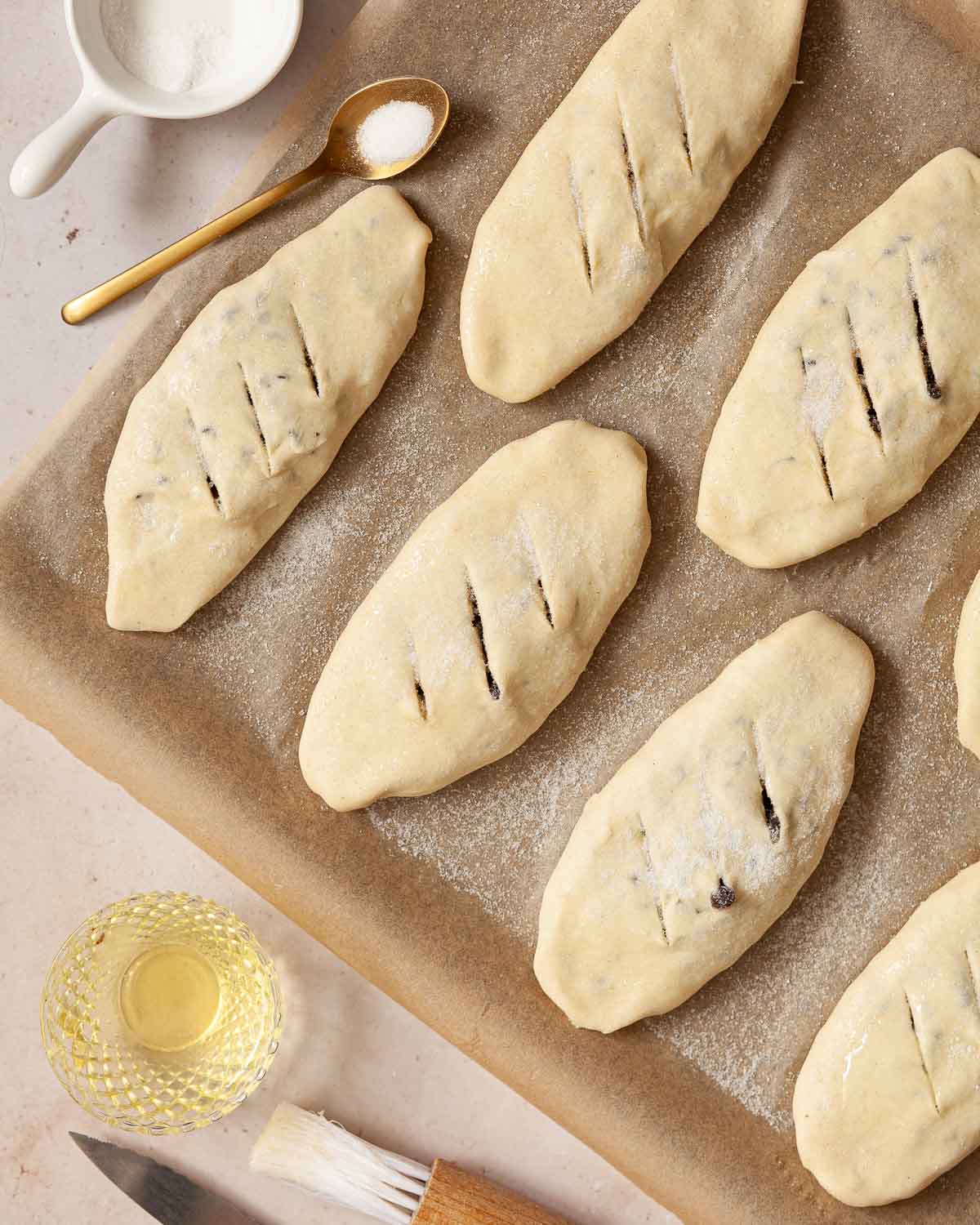
Step 9. Lay the pastries on a baking sheet lined with parchment. Cut three slashes across the top of each cake, brush with egg white, sprinkle with caster sugar and bake for around 20 minutes until golden and the pastry is cooked through.
Expert Tips
Top Tip: Never skip the chilling of the pastry dough. Pastry is always easier to handle when sufficiently chilled and in the case of this quick puff pastry it is vital to help build up the lamination.
- Store-bought puff pastry can be used in place of homemade.
- Each pastry circle needs to be approximately 13-15 cm in order to hold the filling. If you make them too small you will have leftover filling and end up with tiny pastries.
- Ideally, roll your pastry into a rectangle approx 30 cm x 50 cm – so that 6 circles can be cut from it.
- Carefully stack the off-cut pastry pieces on top of each other before re-rolling to cut 2 more circles. This preserves the lamination in the pastry. Do not scoop the offcuts up into a ball as this will destroy the lamination.
- It’s best to divide the filling across all circles before beginning to seal any of them so that the filling can be shared out evenly.
- Seal one circle at a time to avoid the egg drying out.
Frequently asked questions
There are a few small differences between Banbury cakes and Eccles cakes:
1. Traditional Banbury cakes are made using puff pastry whereas traditional Eccles cakes are made from flaky pastry.
2. Whilst mixed peel is essential to Banbury cakes it is debatable whether it forms part of an authentic Eccles cake. If it is included much less peel is added to Eccles cakes.
3. Similarly, it is debatable whether spices are truly part of an authentic Eccles cake recipe. If so, then it is likely to be nutmeg and cinnamon whereas Banbury cakes definitely involve spice, namely nutmeg and mixed spice.
4. Eccles cakes do not include rum or rosewater. Banbury cakes do.
5. Beaten egg glazes Eccles cakes whilst egg white is used to glaze Banbury cakes.
6. Of coure, Banbury cakes are oval in shape whereas Eccles cakes are round.
There are a few differences between Banbury cakes and Chorley cakes:
1. Banbury cakes are made from puff pastry whilst Chorley cakes require shortcrust pastry.
2. Chorley cakes are round whereas Banbury cakes are oval.
3. Both bakes contain currants but Banbury cakes also contain candied peel. Chorley cakes do not.
4. The spices also vary. Banbury cakes use mixed spice and nutmeg whereas Chorley cakes contain only nutmeg.
5. Banbury cakes also include rum and (sometimes) rosewater). Chorley cakes contain neither ingredient.
6. The glaze on Banbury cakes is egg white but the glaze on Chorley cakes is beaten egg.
Mixed spice is a common baking ingredient in the UK typically consisting of cinnamon, nutmeg, ginger, cloves, allspice and often coriander.
Acceptable substitutions for mixed spice would be pumpkin spice mix or masala (chai) spice mix.
Yes, you can. It’s best to reheat Banbury cakes in the oven (150C/300F/ GM2) for 5 minutes. Don’t reheat them in a microwave as doing so will turn the pastry soggy – yuck.
Store your Banbury cakes at room temperature in an airtight container for up to 48 hours. They are, however, best devoured on the day they are baked.
You can freeze Banbury cakes either before or after baking.
To freeze them prior to cooking, prepare them up to, and including, the point of adding the egg white glaze and sugar topping. Open-freeze them on a baking sheet lined with parchment and, when solid, slide them into a freezer container or bag. Label them and keep them frozen for up to 2 months. Bake from frozen by laying them onto a lined baking sheet and cooking for 22-25 minutes at the temperature specified in the recipe card below.
If they are already cooked, let your Banbury cakes cool completely and freeze as soon as possible. Defrost them fully, then reheat for 5-10 minutes to re-crisp the pastry.
Yes, you can make vegan Banbury cakes. You will need to make the pastry using vegan block butter and replace the egg white in the recipe with dairy-free milk alternative such as oat milk or almond milk.
Check that the sugar you are using is also vegan as not all sugar is.
Yes, you can make gluten-free Banbury cakes. Ensure that you either make gluten-free puff pastry or purchase gluten-free puff pastry.
Serving suggestions
Banbury cakes are best served on the day that they are made, barely warm, alongside a cup of tea.
They can, however, also be enjoyed as dessert served warm with clotted cream or custard.
If you fancy enjoying them as part of an afternoon tea at home serve them after the sandwiches and scones alongside treats such as butterfly cakes or strawberry tarts.
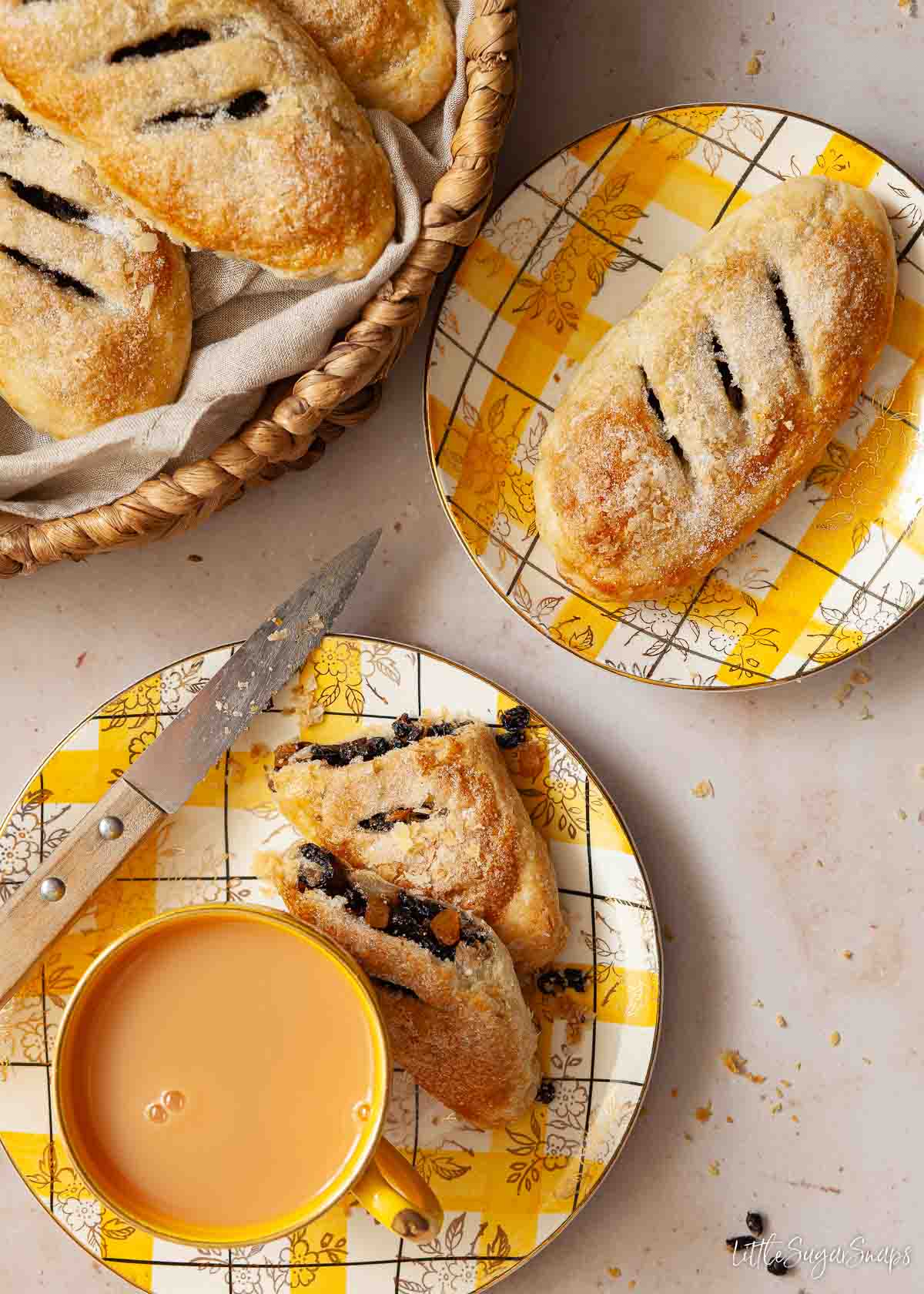
More teatime treats
Have you made this recipe for Banbury cakes? Please give the recipe a rating or leave a comment – I love to hear how you get along with my creations.
Stay in touch: sign up to receive LittleSugarSnaps newsletters to hear when new recipes are published. Or follow me on social media:
📖 Recipe
Want to Save This Recipe?

Banbury Cakes
Equipment
- Circular cookie cutter approx 14cm diameter (or a plate of similar size to cut around)
Ingredients
For the quick puff pastry
- 250 g Plain flour all-purpose
- 185 g Butter cold
- ¼ teaspoon Salt
- 100-125 ml Water ice-cold
For the filling
- 180 g Currants
- 60 g Candied peel
- 30 g Light brown sugar
- 1 teaspoon Ground nutmeg
- ½ teaspoon Mixed spice or pumpkin/ chai spice
- 30 g Butter
- 15 ml Rum dark or amber
- ⅛ teaspoon Rosewater optional
Glaze
- Egg white
- 15 g Caster sugar
Instructions
Make the pastry
- Divide the butter into 4 portions.
- Put the flour and salt into a bowl and stir briefly then add 1 portion of the butter (cubed) and rub it in.
- Pour in ¾ of the water and mix, with a blunt knife, to a soft dough. (Only add more of the water if necessary. If too much water is added the dough turns sticky.)
- Roll the dough into a long rectangle on a lightly floured worktop to approx 4mm thick. Take another portion of the butter, cube it and scatter it over ⅔ of the dough, leaving the final ⅓ empty.
- Fold the empty third of the dough over the top of the dough, bringing it to the centre.
- Fold the other end of the pastry over the top, then rotate the pastry 90 degrees.
- Roll the pastry out in one direction and repeat the folds & 90 degree rotation in the 2steps above (without adding more butter) two more time then cover the pastry with food wrap and chill for 20 minutes.
- Repeat steps 5-7 twice more to incorporate the remaining portions of butter. Chill the finished pastry for 1 hour in the fridge.
Assemble and bake the Banbury cakes
- Preheat the oven to 200℃/ 400℉ and line a baking sheet with parchment.
- Chop the candied peel finely.
- Mix the currants, candied peel, spices and sugar in a mixing bowl.
- Melt the butter and stir it into the bowl along with the rum and rosewater (if using).
- Roll the pastry dough out on a lightly floured worktop and cut circles approximately 14cm diameter (aim to cut 6 from the first roll).
- Pile the off-cut pastry pieces on top of each other (do not squish them together to form a ball). Re-roll the pastry to cut another 2 circles.
- Divide the prepared filling between the 8 circles.
- Lightly brush halfway around the edge of one circle of pastry with egg white and bring the edges up to meet in the centre, pressing the wet and dry edges together. Tuck in the ends. Repeat with the other cakes.
- Turn the Banbury cakes over so that the seal is underneath and lightly flatten them to form ovals. Lay the pastries on the prepared baking sheet.
- Cut three slashes across the top of each cake, brush with egg white and sprinkle with caster sugar.
- Bake for around 20 minutes until golden and the pastry is cooked through.
Notes
- Never skip the chilling of the pastry dough. Pastry is always easier to handle when sufficiently chilled and in the case of this quick puff pastry it is vital to help build up the lamination
- Store-bought puff pastry can be used in place of homemade.
- Each pastry circle needs to be approximately 13-15 cm in order to hold the filling. If you make them too small you will have leftover filling and end up with tiny Banbury cakes.
- Ideally, roll your pastry into a rectangle approx 30 cm x 50 cm – so that 6 circles can be cut from it.
- Carefully stack the off-cut pastry pieces on top of each other before re-rolling to cut 2 more circles. This preserves the lamination in the pastry. Do not scoop the offcuts up into a ball as this will destroy the lamination.
- It’s best to divide the filling across all circles before beginning to seal any of them so that the filling can be shared out evenly.
- Seal one circle at a time to avoid the egg drying out.
- Store your Banbury cakes at room temperature in an airtight container for up to 48 hours. They are, however, best devoured on the day they are baked.
- It’s best to reheat Banbury cakes in the oven (150C/300F/ GM2) for 5 minutes. Don’t reheat them in a microwave as doing so will turn the pastry soggy – yuck.

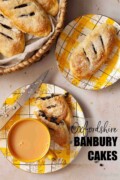

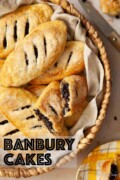
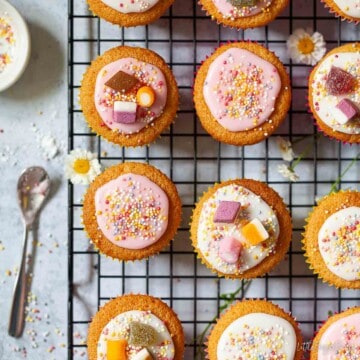
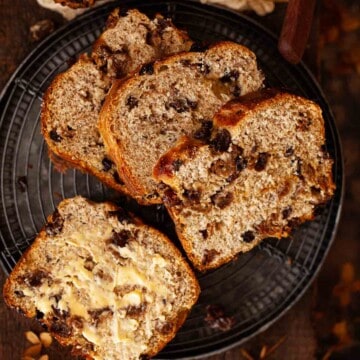
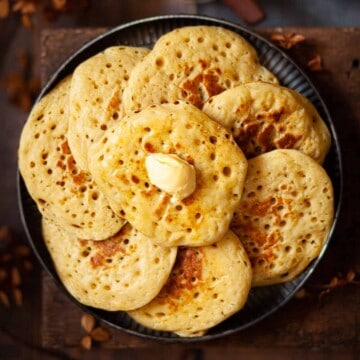
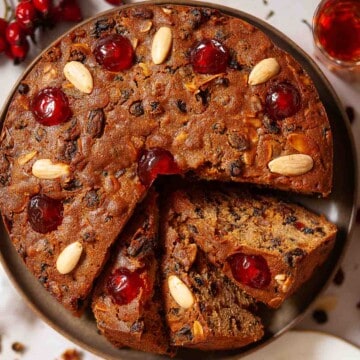

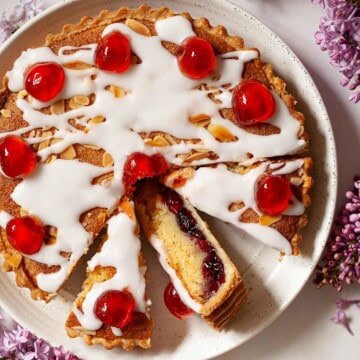
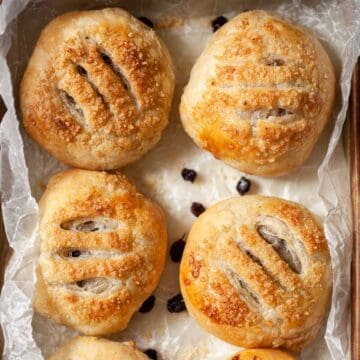
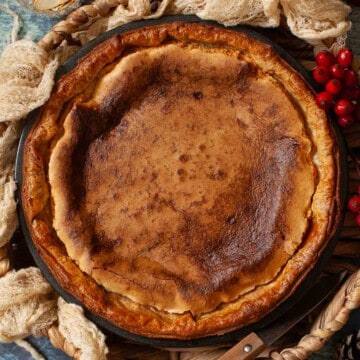
Jane Coupland
These are a true British classic. Perhaps not as well-known as the Eccles cake, but they should not be overlooked! I hope you enjoy my recipe.